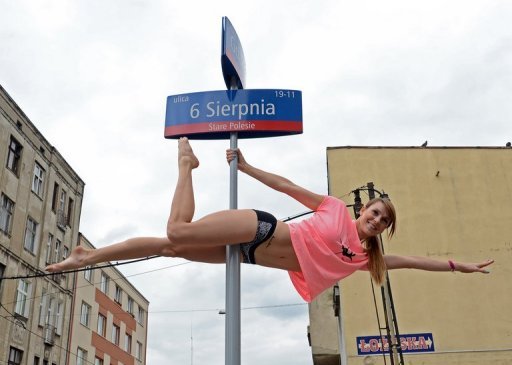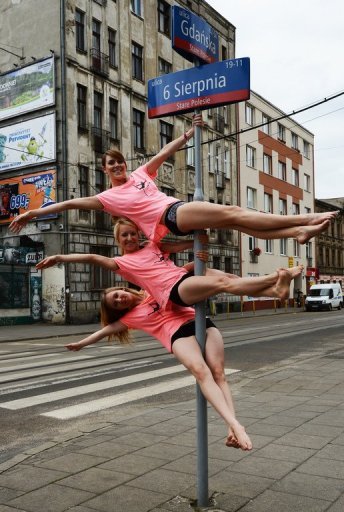
Talk about a traffic stopper: three pole dancers in central Poland have been honing their skills on street corners, throwing their legs around signposts to the surprise and delight of passersby.
Clad in black booty shorts and neon pink T-shirts on a recent afternoon in downtown Lodz, the barefoot and pony-tailed women checked the sidewalk for glass.
With all clear on the corner, it was time to hop on that signpost.
“Which pose should we start with? The Frog, the Scorpion or the Foreign Lady?” Karolina Kicinska, 25, asked her partners-in-poles.
The trio first swung their bodies around signposts this spring for a photo shoot for their Avocadoo dance studio. Drawing a positive response from onlookers, they decided to make it a regular gig.
“Pole-dancing is usually associated with erotic dance, strip clubs, go-go dancing…. Through street pole-dancing we want to break those stereotypes,” said Kicinska, a passionate participant who hopes to open it up to a wider audience.
“Pole-dancing is a real sport and even an art that combines acrobatics, gymnastics and fitness. It requires a lot of strength and flexibility,” added the tall brunette, a molecular biotechnology student at the Medical University of Lodz.
Since making its way over to Poland from the United States and Australia a few years ago, the performance art has flourished despite its sleazy stigma.
The women train regularly, usually indoors but at least once a week outside their studio in this working class city dubbed the Polish Manchester.
“Obviously in winter, autumn and the very beginning of spring we don’t hit the streets because of the cold and rain,” said Iwona Drzymala, 24, a dance education student.
After warming up with stretches and jumping jacks, the women take to the signposts for an hour at a time. They swing around the pole, then hang upside down or straddle it crosslegged, with their leg and abdominal muscles on prominent display.
Flashing smiles and flipping around with gusto, the women channel Gene Kelly’s famous lamppost routine from “Singing in the Rain” — minus the music and the umbrella twirls.
But their toothy grins mask the enormous effort involved.

“It’s much easier in the studio. The poles are made of chromed steel, all smooth and easy on the hands,” said Drzymala, her palms powdered for traction.
Not so with signposts. Often old and rusty, with the paint chipping off, they can tear up a hand. They also vary in size, making it tricky to get a good grip.
Where the ideal diameter is four to five centimetres (1.6-2.4 inches), street poles are much thicker and rougher to boot.
“That’s why we go home with plenty of bruises all over” our bare hands and legs, said Kicinska, who has been pole-dancing for two years and now teaches it too.
Beyond Poland, urban pole-dancing has also cropped up in places ranging from the streets of Mexico City to the London underground, creating a stream of double-takes and gawking among the admiring public.
“They’re marvelous, really marvelous,” said onlooker Stanislawa Sztuc, a local retiree stopping to watch the Polish pole dancers on her way home from grocery-shopping.
“Acrobatics on signposts! Why not? It’s very original. It draws attention,” added student Konrad Chachula.
“But it could also be dangerous for drivers” who may get distracted, he said, his eyes glued to the smiling female safety hazards.
No problems yet, said Kicinska, who got a honk of approval from a fire truck while pretzeling herself around a signpost.
“We get really great reactions, people applaud and compliment us,” she said, adding that law enforcement had yet to take notice.
She spoke too soon, however. Within an hour the trio caught the eye of two young policemen who asked whether they had a permit to slide around on signposts.
“But we’re doing nothing wrong,” Kicinska protested. “We aren’t damaging the poles.”
Unmoved, the officers took down their names and issued a warning, cutting short their street show — just that day.
Tags:
Love and Sex
